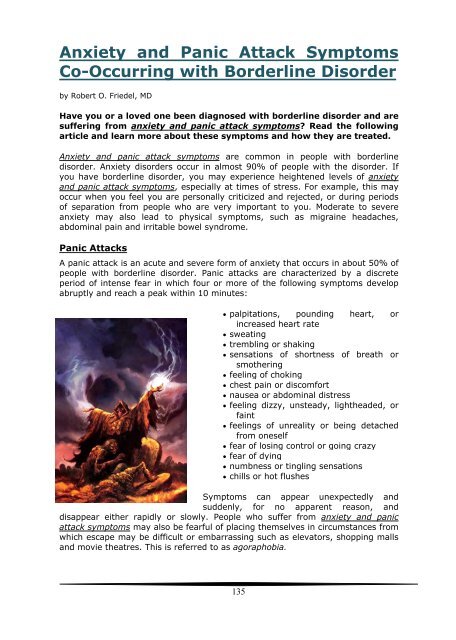personality disorders explained
Antisocial Personality Disorder, Codependence, Narcissism and Borderline
Antisocial Personality Disorder, Codependence, Narcissism and Borderline
You also want an ePaper? Increase the reach of your titles
YUMPU automatically turns print PDFs into web optimized ePapers that Google loves.
Anxiety and Panic Attack Symptoms<br />
Co-Occurring with Borderline Disorder<br />
by Robert O. Friedel, MD<br />
Have you or a loved one been diagnosed with borderline disorder and are<br />
suffering from anxiety and panic attack symptoms? Read the following<br />
article and learn more about these symptoms and how they are treated.<br />
Anxiety and panic attack symptoms are common in people with borderline<br />
disorder. Anxiety <strong>disorders</strong> occur in almost 90% of people with the disorder. If<br />
you have borderline disorder, you may experience heightened levels of anxiety<br />
and panic attack symptoms, especially at times of stress. For example, this may<br />
occur when you feel you are personally criticized and rejected, or during periods<br />
of separation from people who are very important to you. Moderate to severe<br />
anxiety may also lead to physical symptoms, such as migraine headaches,<br />
abdominal pain and irritable bowel syndrome.<br />
Panic Attacks<br />
A panic attack is an acute and severe form of anxiety that occurs in about 50% of<br />
people with borderline disorder. Panic attacks are characterized by a discrete<br />
period of intense fear in which four or more of the following symptoms develop<br />
abruptly and reach a peak within 10 minutes:<br />
palpitations, pounding heart, or<br />
increased heart rate<br />
sweating<br />
trembling or shaking<br />
sensations of shortness of breath or<br />
smothering<br />
feeling of choking<br />
chest pain or discomfort<br />
nausea or abdominal distress<br />
feeling dizzy, unsteady, lightheaded, or<br />
faint<br />
feelings of unreality or being detached<br />
from oneself<br />
fear of losing control or going crazy<br />
fear of dying<br />
numbness or tingling sensations<br />
chills or hot flushes<br />
Symptoms can appear unexpectedly and<br />
suddenly, for no apparent reason, and<br />
disappear either rapidly or slowly. People who suffer from anxiety and panic<br />
attack symptoms may also be fearful of placing themselves in circumstances from<br />
which escape may be difficult or embarrassing such as elevators, shopping malls<br />
and movie theatres. This is referred to as agoraphobia.<br />
135

















